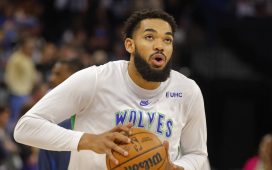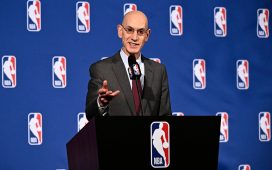They used to say Stephen Curry wasn’t a point guard.
On Thursday morning, he dropped his most important assist of the season, perhaps of someone’s life. He used his legendary gravity to set up Dr. Anthony Fauci, an immunologist who has become a central figure in the nation’s fight against the coronavirus pandemic.
The future won’t forget this moment in history, when COVID-19 stopped sports, shut down countries and brought an Industrial Age terror to attack the facade of modernity’s invincibility. And during this time, Curry used his 44 million combined followers on Instagram and Twitter to give a platform to the voice people needed to hear. In a season when Curry has barely played, when he watched a dynasty crumble around him, he still managed to come through in the clutch.
“That’s really one of the reasons I wanted to have this Q&A,” Curry said in his conversation with Dr. Fauci on Thursday morning, “and hopefully reach a different demographic or people that, you know, are interested in the facts of what’s going on. Because you see all the different visuals of people at the beach, at parks, like in crazy public gatherings and not really adhering to that social distancing kind of concept.”
As the images of young adults still gathering at bars and beaches and restaurants flood the internet, it was clear the danger of this pandemic seemed to be lost on parts of the Generation Z audience and even some millennials. The game plan this nation needed to curb this thing was coming apart, leading to rumors and false whispers of impending martial law and at least in part contributing to the suffocating of the health care system. So, in stepped Curry, who has the ear of the very audience that needs to listen, doing a Q&A on Instagram Live to get the message where it needs to go.
And in doing so, Curry, the greatest shooter basketball has ever seen, became the point guard of a national crisis, of a generation even.
Bryant Barr, Curry’s friend and former Davidson teammate who is also president of SC30, Inc., Curry’s company, saw Fauci doing an interview and a corresponding Twitter comment suggesting that Fauci should do one with a celebrity to engage a younger audience. LeBron James and Taylor Swift were among those recommended. But Barr knew the perfect guy. He convinced Curry to do it and coordinated with the National Institute of Allergy and Infectious Diseases.
In so many ways, Curry makes perfect sense for this. On brand, as they say. He has positioned himself to be this kind of ambassador. A superstar of the people. The uniqueness of his celebrity proved captivating to teenagers and even preteens. His boyish looks and normal size, relative to his NBA peers, made him a pied piper for the younger demographic.
Now, more than a decade after he burst onto the national scene in the NCAA Tournament with Davidson, five years after he first became an MVP, many of his fans are young adults. And a large percentage of them are, typically, drunk on invincibility. And they need to understand the gravity of this pandemic and the danger they’re in.
So Curry became their representative, their access. He asked their questions, from submissions on Twitter, and conveyed their confusion or concern.
“We’re not overreacting, right?” Curry asked Fauci.
“You’re absolutely right,” Fauci responded to the two-time MVP. “This is serious business.”
Not only does Curry have the ear of the demographic, he has the credibility. It’s not just the size of his audience, but the image he has carefully crafted over his 11-year NBA career. His interest in social justice and willingness to step into the controversial fray — whether it was criticizing his own shoe company, supporting Colin Kaepernick or rejecting a White House invitation and inciting a beef with President Donald Trump — has made him unquestionably qualified and ready for this. He’s not the only one, but he’s clearly among the most willing.
The result was a clear, honest and digestible conversation — which is meaningful amid the information overload this pandemic has caused. For some who have already dived into this issue, the questions and answers might have been basic and well known. But they weren’t for those who are gobbling up articles and charts and the instructions of scientists. This dime wasn’t for you.
According to a 2018 Pew Research Center study, 80 percent of Gen Z teens turn to YouTube to learn. According to a study released last June, 49 percent get their news from some form of social media. They aren’t reading dense articles or watching CNN on loop. They also are less trusting of media. So Curry creating a platform, a large one, to disseminate facts and debunk myths is extra meaningful to that audience.
So it is important that he asked if this new coronavirus was like the flu.
“It’s similar in some respects, Steph,” Fauci said, “in that it’s a respiratory illness that’s transmitted by the respiratory root. It gives a degree of pathology that’s mostly pneumonia. The reason it’s different is it’s very, very much more transmissible than flu. And, more importantly. it’s significantly more serious.”
Curry even asked, for the record and the sake of the target audience, if the idea that young people aren’t really harmed by this virus is real. A critical question considering on Wednesday the Department of Public Health in Philadelphia said nearly 50 percent of the positive tests for COVID-19 in the city are from the millennial and Gen Z demographics.
“If you look at China, you look at Europe, you look at South Korea,” Fauci explained, “it predominantly is reasonably benign, if you want to call it that. You get sick but you don’t get into serious trouble if you’re young. Very heavily weighted towards the elderly and those with underlying conditions. Heart disease. Lung disease. Diabetes. Kidney disease. Those are the people who have a higher degree of mortality. We know that for sure. We are seeing that a lot now in the United States. But what we are starting to see is that there are some people who are younger, people your age — young, healthy, vigorous — who don’t have underlying conditions, who are getting seriously ill. It still is a very, very small minority. But it doesn’t mean that young people like yourself should say, ‘I’m completely exempt from any risk of getting seriously ill.’”
And, of course, Curry asked perhaps the most pressing question of all. When will we be free to resume our lives?
“That’s a great question, Steph,” Fauci said, “and that’s what we deal with on a daily basis, what we sit down in the Situation Room at the White House every day to go over that. What you need is you need to see is the trajectory of the curve start to come down. We’ve seen that in China. They went up and down. They’re starting to get back to some normal life. They’ve got to be careful they don’t reintroduce the virus into China. But they’re on the other end of the curve. Korea is doing that. They’re starting to come back down. Europe, particularly Italy, is in a terrible situation. They’re still going way up.”
The curve has become part of the lexicon of this global pandemic. It’s an idea derived from charts that monitor growth in the number of cases. Flattening the curve means slowing growth in the number of cases. This isn’t necessary just to prevent surging death totals but also to avoid overwhelming the health care system. In 2017, the U.S. Department of Health and Human Services estimated that a moderate pandemic would require 160,000 beds in intensive care units and a severe pandemic would raise that demand considerably.
But if you aren’t reading articles with such information in The Atlantic, the concept might be foreign and discussion about how the country gets back to normal might not be so clear. So Curry asked.
“The United States is a big country,” Fauci continued. “We have so many different regions. Like, New York City right now is having a terrible time, and yet there are places in the country that are doing really quite well. You can probably identify people, contact trace and get them out of circulation. Whereas in NYC, it’s doing what’s called mitigation, trying to prevent as best you can, the spread. So in direct answer to your question, We can start thinking about getting back to some degree of normality when the country as a whole has turned that corner and start coming down. Then you can pinpoint cases much more easily than getting overwhelmed by cases, which is what’s going on in New York City.”
Since he entered the NBA and certainly since he’s become a sports icon, Curry has been calculated about projecting humility. He’s the down-to-earth family man as much as a ridiculously wealthy and popular celebrity can be. He has executed immeasurable amounts of charity, assumed the responsibility of being a pillar in a Bay Area community that adopted him and been proactive about using his voice for good. The Curry camp has worked to preserve his aura of accessibility, to highlight his character, to underscore his bent on being a force of good in the world.
So when this situation called for a messenger, one to deliver a timely assist, Curry was the perfect choice. He could have, like many others, used his voice to share the necessary information. He could have made a PSA video distributing the necessary talking points. He could have done a media tour and given an interview to get this information out there, as he has done for many of his endorsements.
But fittingly, Curry chose a unique approach. He drew the attention and set up Fauci. Because he’s a point guard, the exact kind needed in these times.
(Photo: Patrick McDermott / Getty Images)
Read more quality sports coverage with a free 7-day trial
If you enjoyed this article, start a free trial today to get full access to all the smart, in-depth coverage on The Athletic, then get 25% off the annual plan.






